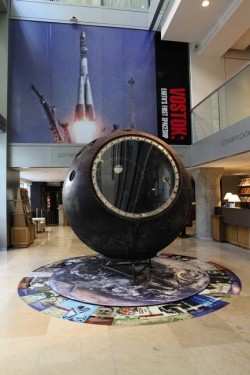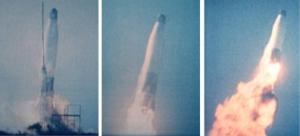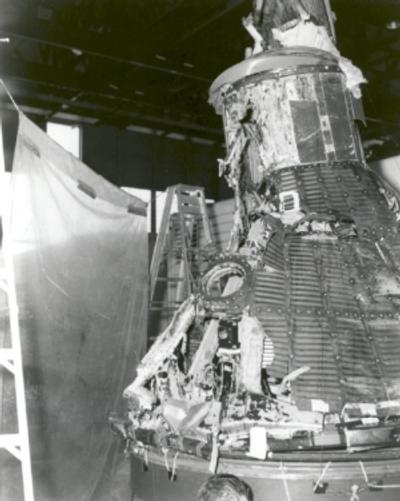A Booster The Blows Up As Often As It Goes Up
Part 1 of 2 By Wes Oleszewski
On the 12th day of April 1961, deep behind the Iron Curtain of
the Soviet Union and under absolute secrecy, cosmonaut Yuri Gagarin
was launched into orbit. After circling the earth one time his
Vostok spacecraft reentered the Earth's atmosphere. Somewhere
around 23,000 feet Gagarin blew the hatch, ejected from the
spacecraft and parachuted to the earth. He thus became the first
human to orbit the earth. At that exact moment in time the schedule
for astronauts of United States to fly in space consisted of a
series of seven manned Mercury Redstone suborbital flights followed
by an equal number of manned Mercury Atlas orbital flights. First
of these flights were scheduled to take place on the second day of
May 1961 and its pilot would be Alan Shepard.
Vostok Capsule

Exactly where the Soviets were in their progress toward
achieving spaceflight was unknown to everyone in the West prior to
Gagarin’s flight. Indeed NASA's manned space efforts were
trudging along lethargically constrained by politics and a meager
budget allotted it by the Eisenhower administration. When the
success of Gagarin’s spaceflight was revealed to the West
everything changed.
Similar to the situation our nation finds itself in today, on
that April day in 1961 NASA found itself without the capability to
place US astronauts into orbit aboard any launch vehicles in the
United States inventory while Russia was happily and successfully
able to place people into orbit atop their reliable R7 booster. The
difference between then and now being that not only were the
American people actually paying attention to the shortcoming but
the President of the United States himself was actually willing to
lead the nation toward rectifying the situation. In less than one
month president Kennedy challenged the nation and the Soviet Union
to a space race. Although today it seems to be politically
acceptable for the president to offer the premise that the United
States can "lead from behind," such was not the case in 1961. It
was the era of the "Cold War" between the United States and the
Soviet Union and JFK was not about to allow the Soviets to win this
skirmish. Likewise, the United States Congress unified behind the
president and provided the funds requested to energize America's
space program.
Immediately the schedule of flights for United States astronauts
was drastically revised. The suborbital, manned Mercury Redstone
flights were scaled back from seven flights to only two flights.
Following that second manned Mercury Redstone flight the effort was
to be directed toward manned orbital flights atop the Atlas
booster. In the scheduled flight rotation of astronauts the third
man up was slated to be Marine Corps Lieut. Col. John Glenn.
Atlas Booster Failures

Unfortunately, the Atlas booster that Glenn would ride had seen
a troubled childhood. In 1958, 6 out of 14 launches failed and 1959
was not much better as 10 out of 23 failed. In that same year, from
January to June, a total of 8 vehicles in a row failed and the most
embarrassing had to be number 7. On May 18, Atlas 7D was launched
with the brand new Mercury 7 astronauts there as spectators. The
vehicle exploded almost directly overhead as range safety hit the
“Command Destruct” button. In the year of 1960 the
Atlas was still batting about 500 as 14 out of 33 launches failed,
not counting Agena vehicle failures. In 1961, just one year before
manned flights on the Atlas were scheduled, 13 out of 37 Atlas
launches failed. Granted, most of the failures were
“R&D” launches, but the reputation still hung over
the Atlas.
Still, the space race was fresh off the starting line and
Mercury was America’s only bet to put a man into orbit. Atlas
was not a 2 stage rocket, rather it was a single stage rocket that
dropped 2 of its 3 engines at two minutes and 10 seconds after
launch. The center “sustainer” engine would continue to
burn until the 5 minute point after liftoff and then shut down. Two
small Vernier engines that had done some of the steering during
powered flight would continue to burn shortly and correct
trajectory errors. For manned flight a Launch Escape System (LES)
was added along with the Mercury spacecraft and the Mercury Atlas
was pressed into service.
Recovered MA-1 Capsule

First of the Mercury Atlas launches took place on September 9,
1959, consisted of the Atlas D booster with a boilerplate Mercury
capsule minus the escape tower. Planned to send the capsule on a
ballistic, sub-orbital path the test was dubbed “Big
Joe.” At BECO (booster engine cut-off) the two dead engines
failed to drop off of the Atlas and then at SECO (sustainer engine
cut-off) the capsule failed to separate. After several minutes and
depletion of all the RCS fuel, the capsule came loose and dropped
inertly into the atmosphere. Because the capsule was designed with
an off-set center of gravity that would allow it to passively seek
a blunt end forward attitude as it contacted the atmosphere, it
survived reentry and was actually recovered. Nearly 11 months later
on July 29, 1960 the test was repeated with MA-1. On that flight
the Atlas exploded while trying to push the Mercury capsule’s
mass through the area of maximum aerodynamic pressure (Max-Q).
Strengthening a small area of the Atlas adapter was the proposed
cure to get the vehicle through Max-Q and MA-2 would be the test
flight. A full Mercury spacecraft was loaded onto Atlas 67-D and on
March 21, 1961 that time the sub-orbital flight was a complete
success. Oddly, the “fix” to the adapter was only
needed for MA-2 because Atlas 67-D was the last of the all
“thin skinned” boosters to be used in Mercury, MA-3
would fly with Atlas 100-D a thicker skinned version of the
booster. MA-3 turned out to be a successful failure as the booster
lifted off on April 25, 1961 and went straight up… and just
kept going straight up when it should have pitched over. Again,
Range Safety hit the command destruct and the Atlas blew up
directly overhead. This time, however, the capsule had an active
LES tower and the abort sequence activated with the booster’s
destruct. It pulled the capsule clear in an unplanned, but
successful test of the abort system. MA-4 was to place a full
Mercury spacecraft into orbit with an electronic “astronaut
simulator” aboard. For the first time a Mercury spacecraft
was placed into earth orbit for a once around mission that was
completely successful- the date was September 13, 1961. Two months
later, November 11, 1961, Enos the chimp rode MA-5 on a successful
flight. NASA felt that the time had come to launch astronauts
on the Atlas booster.
All of the Mercury Atlas launchings took place at Cape
Canaveral’s Launch Complex 14. So it was at that place that
on February 20, 1962 John Glenn boarded his Friendship 7 spacecraft
that sat atop a booster that many thought blows up as often as it
goes up. Glenn, like most folks inside the program had a different
perspective. He knew that each individual booster and each
individual launch was its own individual event and every failure
had been a page added to the learning manual that improved the
system as well as his chances of a successful mission. As the year
1962 started, John Glenn was ready to go… but would take
nearly two months for him to complete his three orbit ride into
history.
…To be continued. (Images provided by NASA)

 ANN's Daily Aero-Linx (04.15.24)
ANN's Daily Aero-Linx (04.15.24) Classic Aero-TV: 'No Other Options' -- The Israeli Air Force's Danny Shapira
Classic Aero-TV: 'No Other Options' -- The Israeli Air Force's Danny Shapira Aero-News: Quote of the Day (04.15.24)
Aero-News: Quote of the Day (04.15.24) Airborne 04.16.24: RV Update, Affordable Flying Expo, Diamond Lil
Airborne 04.16.24: RV Update, Affordable Flying Expo, Diamond Lil ANN's Daily Aero-Term (04.16.24): Chart Supplement US
ANN's Daily Aero-Term (04.16.24): Chart Supplement US






